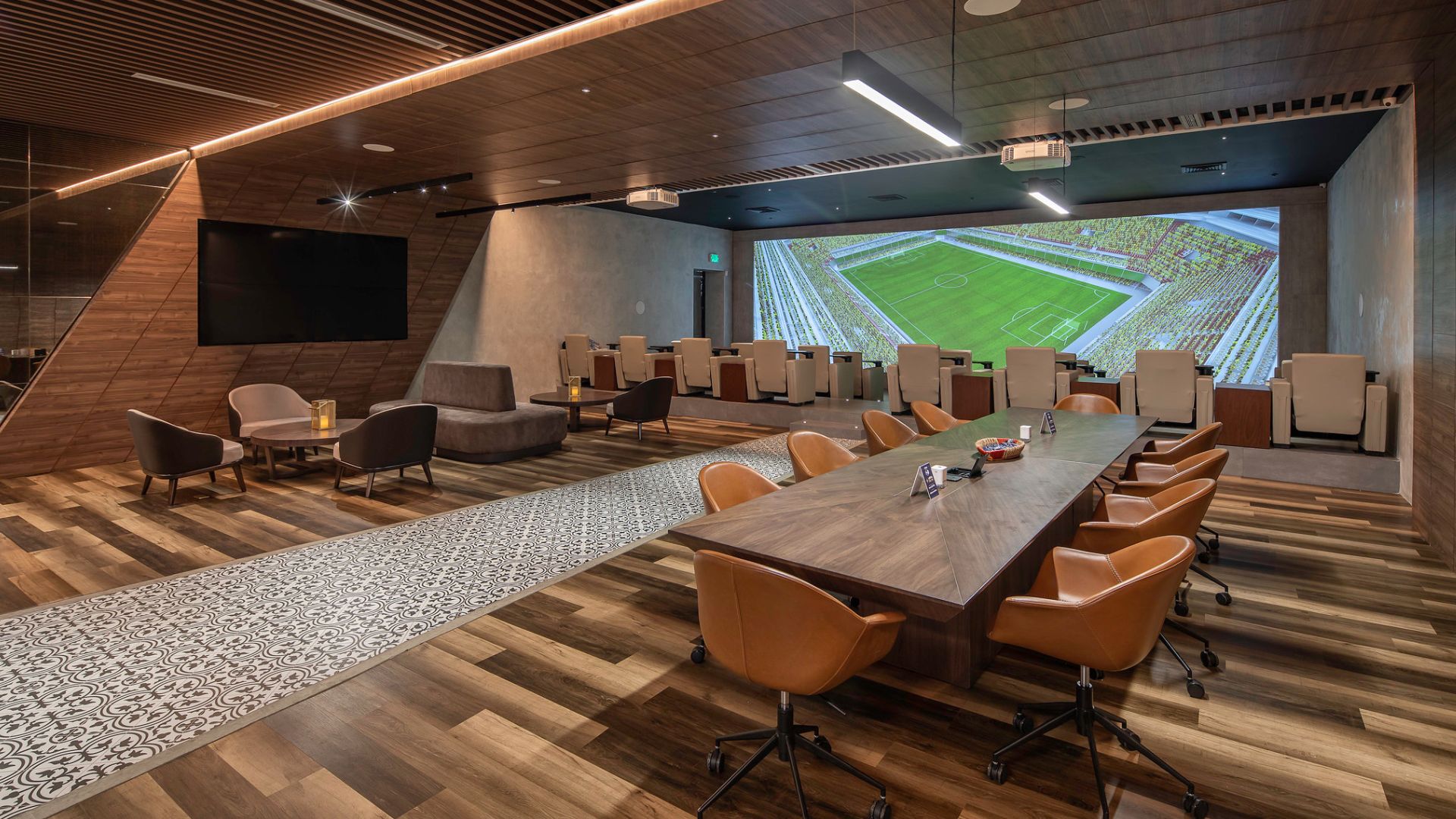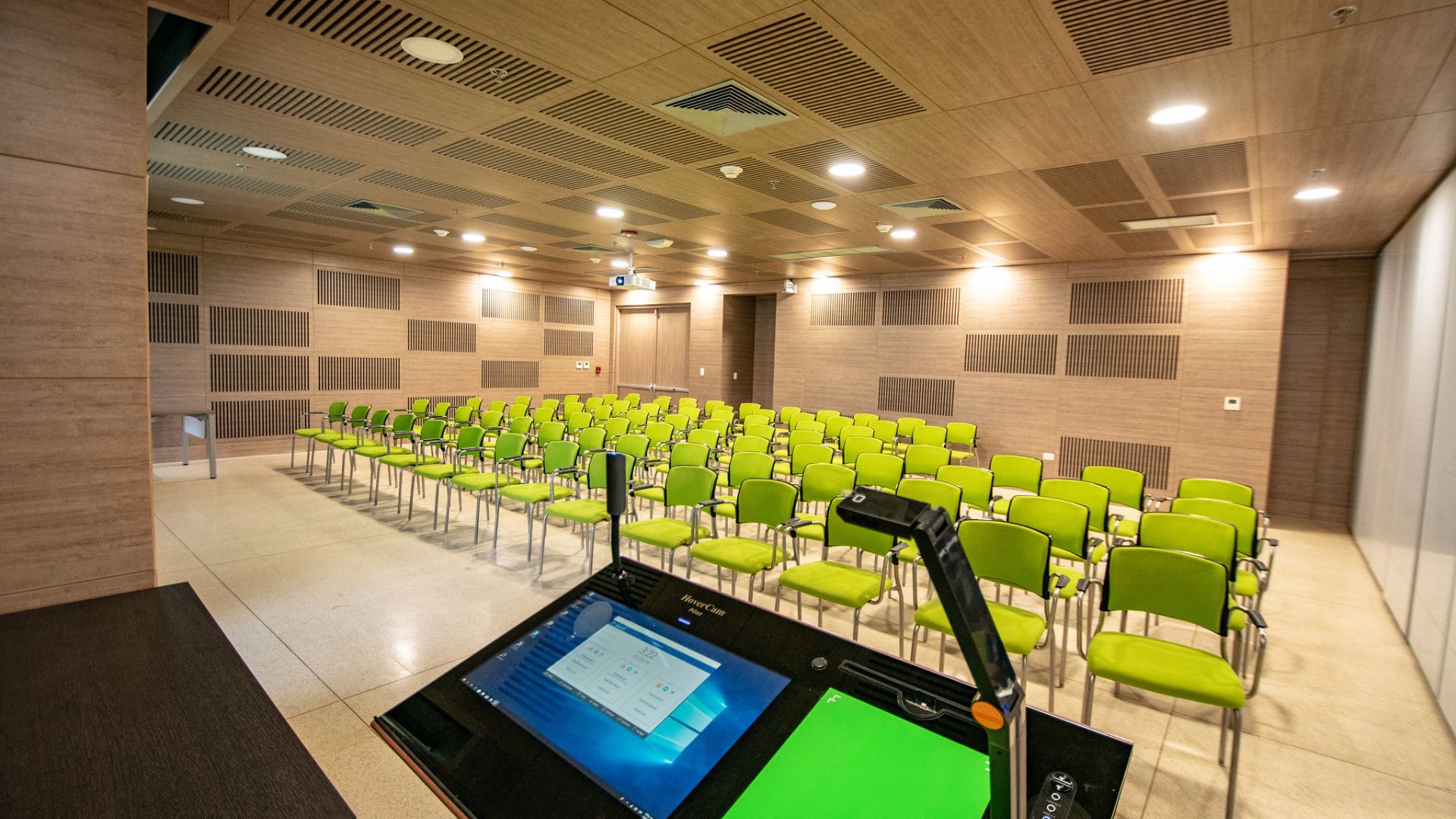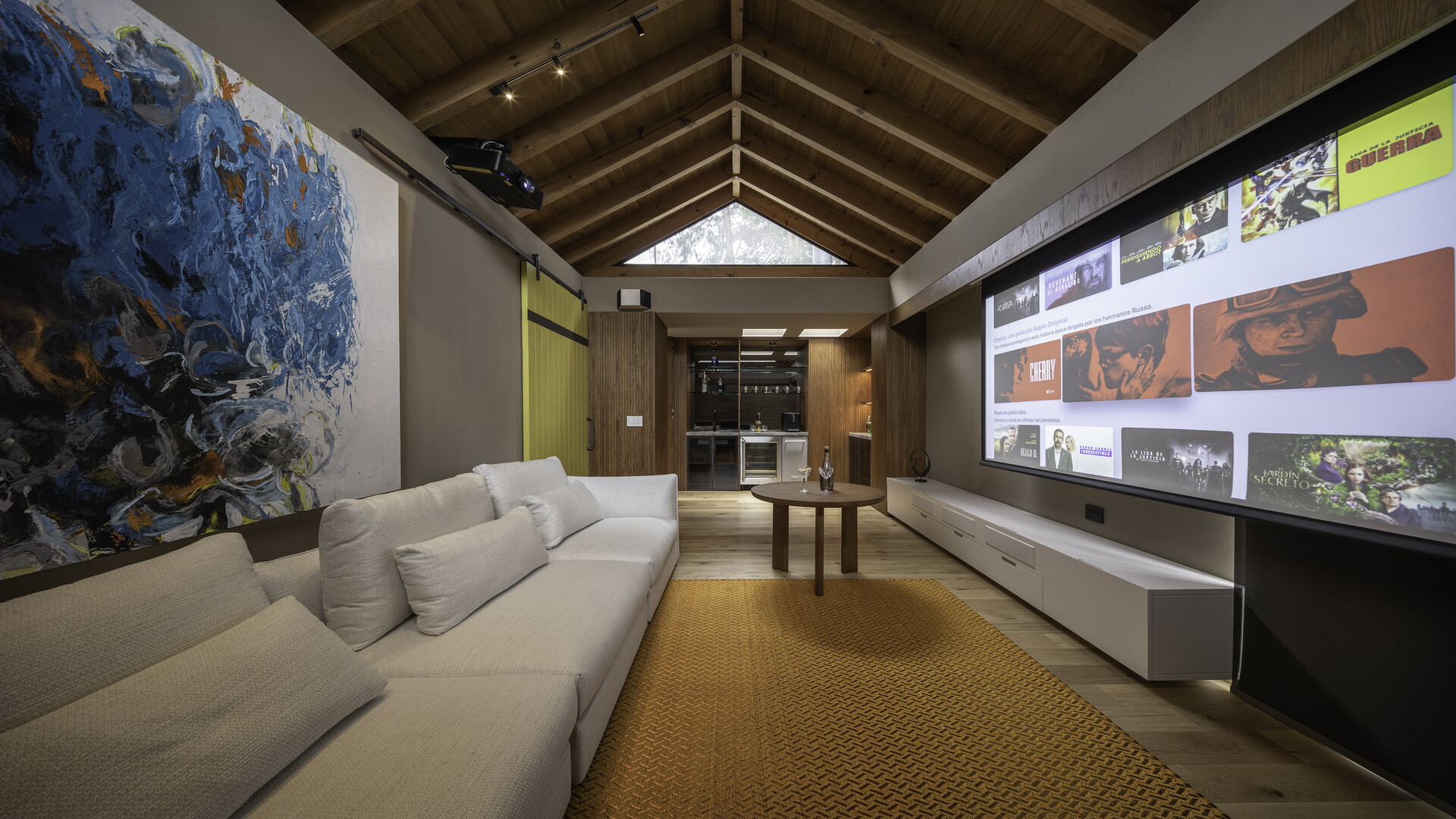Table of contents
Key Takeaways
- Voice-controlled devices like Amazon Alexa and Google Home are transforming home interaction by allowing for the control of smart devices through simple voice commands, offering convenience and a more connected living environment.
- The introduction of AR and VR technologies, especially with devices like Apple Vision Pro, is setting the stage for a future where digital and physical worlds blend seamlessly, offering unprecedented immersive experiences and control over smart home environments.
- The Internet of Things (IoT) is pivotal in creating smarter, more efficient homes through interconnected devices, enhancing areas such as energy management (smart thermostats), security (smart security systems), and convenience (smart lighting).
- Integration with smartphones is revolutionizing home automation by providing remote access and control over home systems, offering enhanced convenience, security alerts, and energy efficiency management directly from users’ fingertips.
- Energy efficiency remains a cornerstone of home automation trends, with smart devices such as thermostats and lighting solutions significantly reducing energy consumption and costs, while promoting sustainable living practices.
- Artificial Intelligence (AI) is dramatically reshaping home automation by learning from user habits to create smarter, more responsive living environments, enhancing security, and providing convenience through voice assistants and predictive maintenance.
Voice-controlled devices

projector, video beam, voice activable
In today’s tech-savvy world, voice-controlled devices have revolutionized how we interact with our homes. These devices not only offer convenience but also pave the way for a more connected and smart living environment. Let’s jump into how Amazon Alexa and Google Home are leading this transformation.
Amazon Alexa
Amazon Alexa, a frontrunner in home automation, enables users to control various smart devices with just their voice. Whether it’s adjusting the thermostat, turning off the lights, or playing your favorite music, Alexa makes it all possible without lifting a finger. Over 100,000 smart home devices from 9,500 brands are now Alexa-compatible, showcasing the expansive reach of Amazon’s ecosystem. Notably, Alexa’s routines feature allows for the customization of multiple actions with a single command, enhancing the user experience by making daily tasks simpler and more automated.
Google Home
Google Home, powered by the Google Assistant, offers a seamless way to manage your day-to-day life and control your smart home devices. With a strong emphasis on search and the vast knowledge base of Google at its core, it’s incredibly adept at answering questions, providing real-time information, and assisting with tasks. Google Home supports a wide range of smart home devices, enabling users to control lighting, security, and entertainment systems using voice commands. Its Voice Match technology stands out by recognizing up to six different users, ensuring personalized help and responses for each member of the household.
In the dynamic field of home automation, voice-controlled devices like Amazon Alexa and Google Home are not just gadgets but essential components of a modern smart home. Their ability to integrate with multiple devices and ecosystems significantly enhances our everyday living, making tasks more convenient and accessible.
AR & VR
As we investigate into the future trends in home automation, it’s impossible to overlook the transformative impact of Augmented Reality (AR) and Virtual Reality (VR) technologies. These innovations are not just reshaping entertainment and gaming but are also making significant inroads into how we manage and interact with our smart homes. With AR and VR, we’re on the brink of entering a world where our interaction with the digital environment is as seamless as with the physical one, reinventing our living spaces in ways we’ve only dreamed of.
Apple Vision Pro
The introduction of Apple Vision Pro marks a significant milestone in the integration of AR and VR technologies into our daily lives. This advanced headset, designed by one of the world’s leading tech companies, is set to revolutionize the way we interact with our smart homes. Apple Vision Pro is not merely a device for immersive gaming or media consumption; it’s a gateway to a new era of home automation.
- Immersive Interface: Apple Vision Pro provides an unparalleled immersive experience that blends the digital and physical worlds. Users can control smart home devices, view information, and even redesign their living spaces virtually without ever lifting a finger.
- Spatial Awareness: Enhanced by state-of-the-art sensors, the headset understands the layout of your home, allowing for intuitive interactions with your smart home devices. Whether it’s adjusting lighting or visualizing a room’s temperature, Apple Vision Pro makes it intuitive.
- Customization at Its Core: One of the standout features of Apple Vision Pro is its ability to personalize the smart home experience. Through advanced machine learning, it adapts to the user’s preferences and habits, offering suggestions and automating tasks in a way that feels natural and effortless.
Apple Vision Pro’s integration into our smart homes signifies a leap towards a future where technology is not just a tool but an extension of our living spaces. It promises to enhance the way we live, providing convenience and a level of customization that was previously unimaginable. With such cutting-edge technology at our fingertips, we’re stepping into a new area of home automation, where our homes are not just connected but truly intelligent, responsive, and harmoniously integrated with our digital lives.
Internet of Things (IoT)

Tv device conected with smartphone and internet
The Internet of Things (IoT) is revolutionizing home automation, making our homes smarter and our lives easier. It’s fascinating to see how connected devices communicate and work together to enhance our living experience. Let’s jump into some key areas where IoT is making a significant impact.
Smart Thermostats
Smart thermostats stand out as a pinnacle of energy efficiency and convenience in the area of IoT. These devices learn from our habits to optimize heating and cooling schedules, ensuring comfort while reducing energy bills. A study shows that smart thermostats can save up to 10-12% on heating and 15% on cooling costs annually. Features like geofencing and remote access via smartphones offer us the flexibility to adjust settings on the go, further garnishing our smart living experience. It’s clear that integrating smart thermostats into our homes not only boosts convenience but also promotes sustainable living.
Security Systems
When it comes to home security, IoT has transformed traditional systems into smart security solutions. Today’s smart security systems provide real-time alerts, live video feeds, and remote monitoring capabilities, allowing us to keep an eye on our homes no matter where we are. These systems can detect unusual activity and immediately notify us, ensuring peace of mind. What’s more impressive is the integration with other smart home devices, enabling automated responses such as turning on lights or locking doors automatically when a threat is detected. This level of automation and connectivity ensures our homes are not just smart but secure.
Lighting Control
Lighting control has undergone a transformation, thanks to IoT advancements. We can now manage lighting with our voice or smartphone, creating the perfect ambiance for any occasion without moving an inch. Programmable scenes and schedules add a layer of convenience, automating lighting based on our preferences or the time of day. This not only enhances our living experience but also contributes to energy efficiency. Statistics reveal that smart lighting can lead to a 60% reduction in energy usage compared to traditional lighting solutions. The ability to control lighting remotely also adds a layer of security, simulating occupancy when we’re away.
Integration with smartphones
In today’s rapidly evolving world, smartphones have become the ultimate remote controls for our lives, especially when it comes to the area of home automation. This integration is not only reshaping how we interact with our living spaces but also setting new standards for convenience and efficiency.
Remote Access and Control
One of the most transformative aspects of integrating smartphones with home automation systems is the unparalleled remote access and control it provides. Whether we’re miles away or just cozy in bed, we can manage almost every aspect of our home with a few taps. This includes:
- Adjusting the thermostat to ensure our home is the perfect temperature when we arrive.
- Controlling smart lights, both in terms of intensity and color, to set the mood or simply make sure we never come back to a dark house.
- Managing security systems, including door locks and surveillance cameras, offering peace of mind no matter where we are.
This seamless control extends to a wide array of devices, making our smartphones the key to a more connected and convenient home.
Notifications and Alerts
Beyond control, the integration of smartphones and home automation brings an added layer of security and awareness through real-time notifications and alerts. We’re now immediately informed about what’s happening in our homes, making it easier to react promptly. Notifications can include:
- Security breaches, such as unauthorized entry attempts or movement detected by surveillance cameras.
- Environmental alerts, like smoke or water leak detection, which can prevent minor issues from turning into major disasters.
- System updates, which inform us about the status of our devices and when they need maintenance or upgrades.
These alerts ensure that we’re always in the loop and can take quick action when necessary, adding a significant layer of extra protection and convenience to our daily lives.
Energy efficiency

Energy efficient light for art gallery.
In the area of home automation, energy efficiency isn’t just a buzzword—it’s a foundational pillar shaping the design and function of smart devices. We’ve witnessed dramatic shifts towards more energy-conscious living environments, driven by innovations in home automation technologies. These advancements aren’t just about reducing our carbon footprint; they’re about optimizing our homes to save on energy bills and increase overall comfort.
At the heart of this revolution are smart thermostats. Unlike traditional models, these devices learn from our habits to adjust heating and cooling systems for optimal performance, ensuring we’re only using energy when absolutely necessary. Companies like Nest and Ecobee are leading the charge, with their devices showing a proven track record of reducing energy consumption. According to recent studies, users can see savings up to 10-12% on heating and about 15% on cooling costs annually.
But it doesn’t stop there. Smart lighting solutions also play a critical role. By using LED bulbs, which consume a fraction of the energy of traditional incandescent bulbs, and pairing them with intelligent sensors that adjust lighting based on occupancy and natural light levels, we’re able to drastically cut down on unnecessary electricity use. The convenience of controlling lights from our smartphones or through voice commands is just the cherry on top.
| Device Type | Average Energy Savings |
|---|---|
| Smart Thermostats | 10-12% on heating |
| 15% on cooling | |
| Smart Lighting | Significant |
Another groundbreaking area is energy monitoring systems. These systems keep us informed about real-time energy consumption, identifying not just how much energy we’re using, but when and where wastage occurs. This insight allows us to make informed decisions about where we can cut back, and automates the process of optimizing energy use throughout our homes.
Also, the evolution of solar-powered smart homes is on the horizon. The integration of solar energy with home automation systems promises a future where homes aren’t just energy efficient but are energy-producing powerhouses. Imagine a home that adjusts its energy consumption based on the electricity generated by its own solar panels, selling excess energy back to the grid. It’s a bold step towards sustainability, and it’s closer than we think.
Artificial Intelligence (AI)
In the area of home automation, Artificial Intelligence (AI) stands out as a transformative force, shaping how we interact with our homes. AI’s integration into home automation systems has paved the way for smarter, more intuitive living spaces that adapt to our needs and preferences with minimal input from us.
At the core of AI’s contribution to home automation is its ability to learn from our habits and routines. Through machine learning algorithms, AI-enhanced devices can analyze our behavior patterns over time, making our homes more energy-efficient and responsive. For instance, smart thermostats equipped with AI can predict our preferred temperature settings for different times of the day and adjust themselves accordingly, ensuring comfort while optimizing energy use.
Another significant advantage of AI in home automation is enhanced security. AI-powered security cameras and systems go beyond traditional monitoring by recognizing familiar faces, detecting unusual activities, and even distinguishing between potential threats and false alarms. This level of sophisticated surveillance not only enhances our home security but also offers peace of mind by keeping us informed about what’s happening at home, even when we’re away.
AI also revolutionizes how we manage our daily tasks through voice assistants such as Amazon Alexa and Google Home. By understanding and processing natural language, these devices help us control smart appliances, set reminders, get information, and much more, using just our voice. This hands-free control is not only convenient but also makes technology accessible to everyone, regardless of their tech savviness.
Looking forward, the integration of AI in home automation promises to bring even more innovations. Predictive maintenance, for example, could use AI to anticipate appliance failures before they occur, scheduling repairs at the most convenient times and preventing costly damages. Likewise, personalized health and well-being recommendations could tailor our living environment to support our physical and mental health, based on data collected from our daily interactions.
With AI, the future of home automation is not just about making our lives easier but also about creating living spaces that truly understand and cater to our individual needs. As AI technology advances, we can anticipate a world where our homes not only react to our commands but proactively anticipate and meet our needs, marking a significant leap towards truly smart living environments.
Conclusion
We’re standing on the brink of a revolution in how we live our lives at home thanks to the advancements in home automation. From voice-activated assistants to the seamless integration of AR and VR technologies the future is bright and incredibly convenient. The strides made in IoT smart thermostats security systems and lighting control are not just about luxury—they’re about sustainability and efficiency. As we move forward the integration of AI into our homes promises to make our living spaces not just smarter but more intuitive catering to our every need with minimal effort from us. The future of home automation is not just about controlling our environment it’s about enhancing our quality of life in every possible way. We’re excited to see where these trends will take us making our homes more connected secure and tailored to our preferences than ever before.
Frequently Asked Questions
What are voice-activated assistants, and how do they contribute to home automation?
Voice-activated assistants, such as Amazon Alexa and Google Home, play a pivotal role in home automation by allowing users to control smart devices through voice commands. They enable the management of tasks like adjusting thermostats, turning off lights, or playing music, thereby simplifying daily routines and enhancing convenience in smart living environments.
How many smart home devices are now Alexa-compatible?
Over 100,000 smart home devices from 9,500 brands are now compatible with Amazon Alexa, highlighting its vast ecosystem and the wide adoption of this technology in home automation.
What unique feature does Google Home offer for personalization?
Google Home stands out with its Voice Match technology that recognizes up to six different users, offering personalized help and responses based on the recognized voice, enhancing the user experience.
How do AR and VR technologies impact home automation?
Augmented Reality (AR) and Virtual Reality (VR) technologies, represented by devices like the Apple Vision Pro, are transforming home automation by blending digital and physical worlds. They allow users to control smart devices, view information, and virtually redesign living spaces, bringing a new level of customization and convenience.
What benefits do IoT-powered smart thermostats offer?
IoT-powered smart thermostats optimize heating and cooling schedules based on user habits, leading to significant energy savings and enhanced comfort by adapting to the preferences and schedules of the homeowners.
How does the integration of smartphones with home automation systems enhance user experience?
The integration of smartphones with home automation systems provides remote access and control over various smart devices, such as thermostats, lights, and security systems. It offers convenience, real-time notifications, and alerts about security breaches or environmental changes, significantly enhancing the user experience.
What role does AI play in home automation?
Artificial Intelligence (AI) is revolutionizing home automation by making living spaces smarter and more intuitive. AI enables homes to adapt to user needs and preferences with minimal input, enhancing energy efficiency, security, and daily tasks management through predictive maintenance, personalized health recommendations, and more intuitive voice assistants.
Our Portfolio
Table of contents











